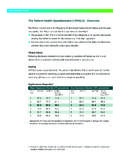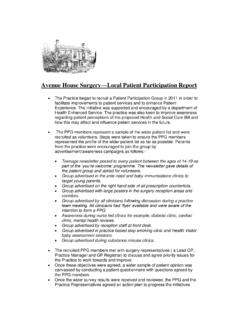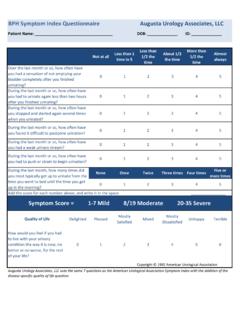Transcription of RR573 - Risk assessment and process planning for …
1 Health and Safety Executive Risk assessment and process planning for bariatric patient handling pathways Prepared by Loughborough University for the Health and Safety Executive 2007 RR573 Research Report Health and Safety Executive Risk assessment and process planning for bariatric patient handling pathways Sue Hignett, Susan Chipchase Amanda Tetley & Paula Griffiths Department of Human Sciences Loughborough University Leicestershire LE11 3TU The obese population in the UK is growing and this group are considerably over-represented in their use of health and social care services. This project aimed to identify and explore the manual handling risks and process planning for bariatric patients by mapping the patient pathway for an emergency admission to identify the major risks by: reviewing public health data to provide an estimate of the current and future bariatric patient population; surveying strategic, clinical and operational policies and procedures for bariatric patient handling; and obtaining case studies of specific incidents and risk management actions.
2 Findings revealed that 40%-70% of Trusts did not have a bariatric policy. These policies are needed to lead the process planning , assessment and management of manual handling risks including the number of staff, provision of appropriate equipment and intra- and inter-agency communication. Spatial risk factors were identified but seemed to have a poor management record for both building and vehicle design with over half of the Trusts with policies not considering space in the policy; almost 30% of ambulances not having specialist vehicles and 33% of respondents reporting inaccessible areas in their buildings. Even with good communication it was not always possible to manage all of the risks, and the provision of appropriate equipment and successful management of pain, safety, dignity and comfort all contributed to successful pathway experiences. This report and the work it describes were funded by the Health and Safety Executive (HSE).
3 Its contents, including any opinions and/or conclusions expressed, are those of the authors alone and do not necessarily reflect HSE policy. HSE Books Crown copyright 2007 First published 2007 All rights reserved. No part of this publication may be reproduced, stored in a retrieval system, or transmitted in any form or by any means (electronic, mechanical, photocopying, recording or otherwise) without the prior written permission of the copyright owner. Applications for reproduction should be made in writing to: Licensing Division, Her Majesty s Stationery Office, St Clements House, 2-16 Colegate, Norwich NR3 1BQ or by e-mail to ii PROJECT TEAM The following individuals contributed directly to this research: Sue Hignett Healthcare Ergonomics and Patient Safety Principal InvestigatorResearch Unit Dept of Human Sciences Loughborough University Paula Healthcare Ergonomics and Patient Safety Co-investigatorGriffiths Research Unit Dept of Human Sciences Loughborough University Susan Healthcare Ergonomics and Patient Safety Research Associate Chipchase Research Unit Dept of Human Sciences Loughborough University Amanda Healthcare Ergonomics and Patient Safety Research Associate Tetley Research Unit Dept of Human Sciences Loughborough University Emma Healthcare Ergonomics and Patient Safety Research Associate Crumpton Research Unit Dept of Human Sciences Loughborough University Joanna Healthcare Ergonomics and Patient Safety Research Associate Prichard Research Unit (Bariatric FSEs)
4 Dept of Human Sciences Loughborough University ACKNOWLEDGEMENTS The project group would like to thank the following people for their help and support particularly with data collection and analysis: Dennis Prosser (HSE), Ian Strudley, (HSE), Stuart Charles (HSE), Anita Rush (Berkshire Community Equipment Services), Alan Hill (East Midlands Ambulance Service), Terry Doherty (East Midlands Ambulance Service), Hilary Pillin (Ambulance Service Association), members of the National Back Exchange Special Interest Group on Bariatrics, members of the National Ambulance Risk & Safety Forum, the participants in the focus groups and case study interviews and the respondents to the questionnaire. We would also like to thank the members of National Back Exchange who participated in the Functional Space Experiment.
5 Huntleigh Healthcare and Liko (UK) kindly loaned equipment and furniture for the FSEs. iii iv CONTENTS Executive xi Background .. xi Aims of the current Method .. xi Results .. xi Discussion and Recommendations For Future bariatric 1 1 Context .. 1 Aims .. 2 2 Literature review .. 3 Background .. 3 3 Method .. 6 Overview of methods .. 6 Equipment 6 Focus groups/group interviews .. 7 Focus Group Population Data Analysis .. 11 Questionnaire Introduction .. 12 NBE Questionnaire Ambulance Questionnaire development .. 13 National Back Exchange and Ambulance Service questionnaire 14 Case 15 Interview protocol .. 15 Research 4 RESULTS .. 19 Equipment .. 19 Focus groups .. 20 Pathway 1.
6 A&E X-Ray ward discharge/nursing home (figure 6).. 21 Pathway 2. Patient home ambulance hospital - home (figure 7)..23 v Pathway 3. Bed and Breakfast bedroom Ambulance Maternity Ultrasound Delivery Home (figure 8).. 23 Specialist Areas: (1) Ward Hygiene, (2) Diagnostics, (3) Mortuary, (figure 9) and (4) Community (figure 10).. 26 Pathway 4: Theatres (figure 11) .. 29 Pathway 5: Admission Care (ward) Transfer - Physiotherapy (figure 12).. 31 Manual handling risks in the Bariatric Patient 34 Patient Factors [A] .. 34 Building/Vehicle Space and Design [B] .. 34 Equipment (manual handling and clinical) and furniture [C] .. 34 Communication [D] .. 34 Organisational and Staff Issues [E].. 35 Population Hip and waist circumference 35 Weight BMI estimations .. 40 Questionnaire National Back Exchange 44 Response rate.
7 44 Respondent Defining bariatric .. 46 Bariatric manual handling Experience of risks and risk 49 Patient 49 Building space/design .. 52 Manual handling training (bariatric)..52 Bariatric 52 Ambulance Response rate .. 54 Respondent characteristics .. 54 Definition of bariatric ..56 Manual handling policies and 56 Patient 56 Risks and Risk assessments .. 58 59 Manual handling training (bariatric)..59 59 Transporting patients .. 60 Case vi Booked, routine, urgent inter-hospital transfer with 2 days notice from urban ambulance 63 Emergency admission to hospital (ambulance perspective).. 63 Emergency admission to hospital (hospital perspective) .. 64 Advanced planning for an emergency admission to hospital (Community Equipment Specialist Nurse).
8 65 Emergency admission to Hospital (Lead Handling Advisor in an Acute Hospital) 66 Bariatric maternity patient (Lead Handling Advisor in an Acute Hospital).. 67 Planned Surgical Admission (Manual Handling Advisor at Acute Hospital)..67 Emergency Admission (Manual Handling Advisor, Acute Hospital Trust) .. 68 Emergency admission to hospital (Ambulance Service)..70 Planned discharge of patient to home from community hospital (Social Services) 71 5 72 Patient Building/Vehicle Space and 73 Equipment (manual handling and clinical) and 74 Communication .. 75 Organisational and staff Organisational 76 Staffing issues .. 77 Limitations .. 78 6 79 Recommendations .. 79 7 Bariatric Functional Space experiment .. 81 Method .. 81 Equipment .. 82 Tasks .. 82 Results .. 83 85 8 87 vii LIST OF FIGURES Figure 1 Examples of body shape.
9 4 Figure 2 Project 6 Figure 3 Draft questionnaire schedule included with ethics 13 Figure 4 Draft Interview 16 Figure 5 Final Interview Schedule .. 17 Figure 6 Pathway 1: Scenario - Journey from Admission to the Ward. Focus Group 16th March 2006 [Secondary Coding refers to Figure 14] ..22 thFigure 7 Pathway 2: Scenario- Community. Focus Group 16 March 2006 [Secondary Coding refers to Figure 14] ..24 Figure 8 Pathway 3: Scenario - Maternity. Focus Group 15th March 2006 [Secondary Coding refers to Figure 14] ..25 Figure 9 Specialist areas (1) Ward Hygiene; (2) Diagnostics; (3) Mortuary [Secondary Coding refers to Figure 14]..27 Figure 10 Specialist areas (4) Community general 28 Figure 11 Scenario: Theatres. Focus Group 16th March 2006 [Secondary Coding refers to Figure 14]..30 Figure 12 Scenario: Focused on location. Focus Group 16th March 2006 [Secondary Coding refers to Figure 14].
10 32 Figure 13 Manual handling risks in the bariatric patient pathway .. 33 ththth thFigure 14 Hip circumference percentiles (50 , 85 , 95 , and 99 ) for males (A) and females (B) aged 15 years and over for the period between 1993 and 2004 .. 36 ththth thFigure 15 Waist circumference percentiles (50 , 85 , 95 , and 99 ) for males (A) and females (B) aged 15 years and over for the period between 1993 and 2004 ..37 ththth thFigure 16 Weight percentiles (50 , 85 , 95 , and 99 ) for males (A) and females (B) aged 15 years and over for the period between 1993 and 2004 ..39 Figure 17 Increase in proportion of adults in obesity Class I (BMI over 30) Class II (BMI over 35), and Class III (BMI over 40) for males (B) and females (C) separately, and for the overall Figure 20 Number of bariatric patients encountered and/or written guidance provided in the population (A).















